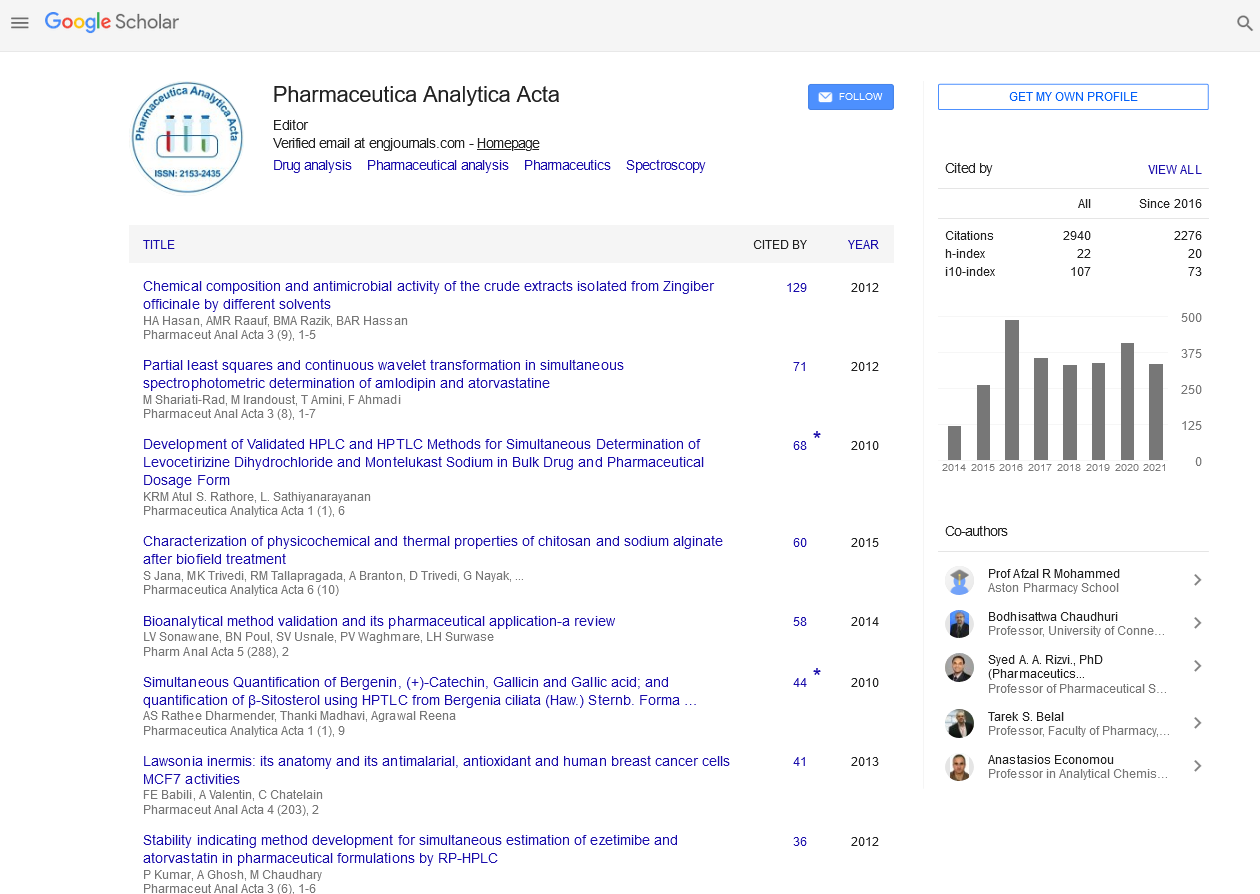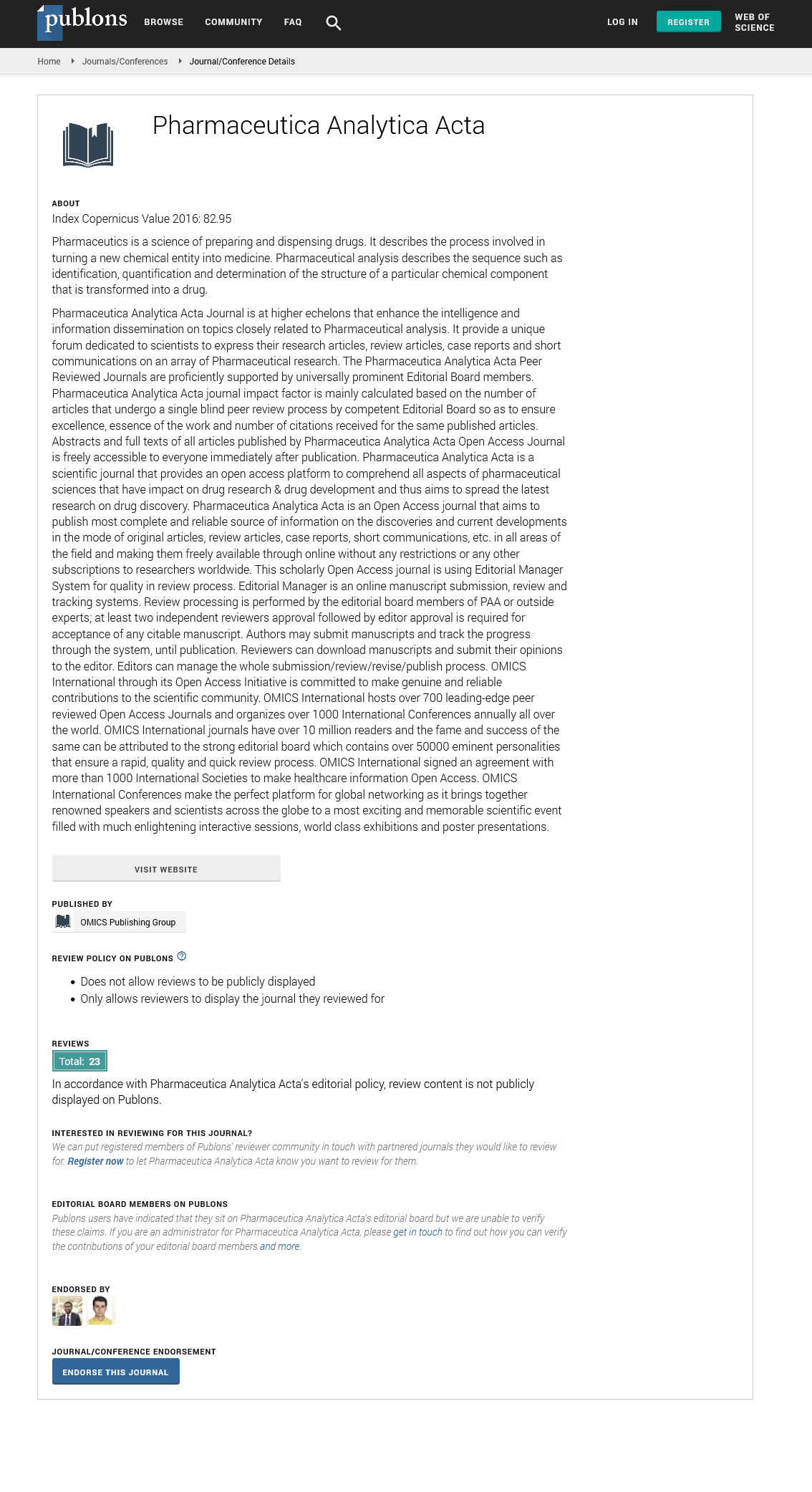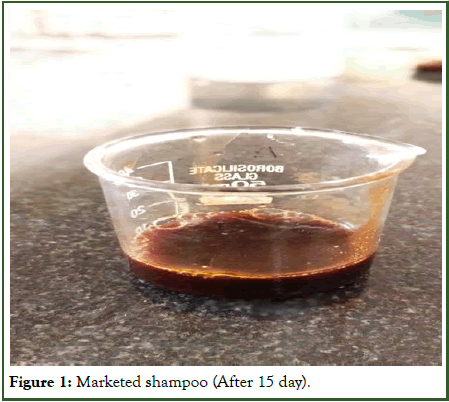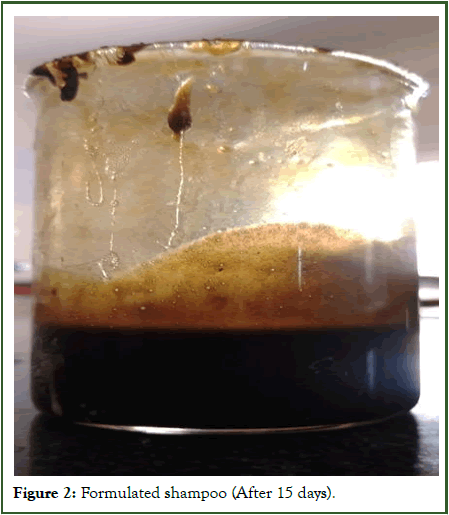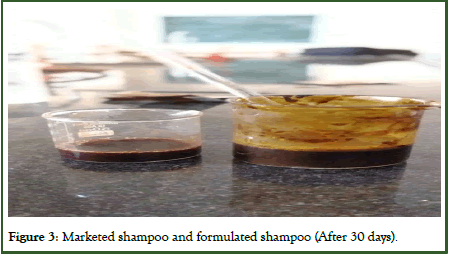Indexed In
- Open J Gate
- Genamics JournalSeek
- Academic Keys
- JournalTOCs
- The Global Impact Factor (GIF)
- China National Knowledge Infrastructure (CNKI)
- Ulrich's Periodicals Directory
- RefSeek
- Hamdard University
- EBSCO A-Z
- OCLC- WorldCat
- Publons
- Geneva Foundation for Medical Education and Research
- Euro Pub
- Google Scholar
Useful Links
Share This Page
Journal Flyer
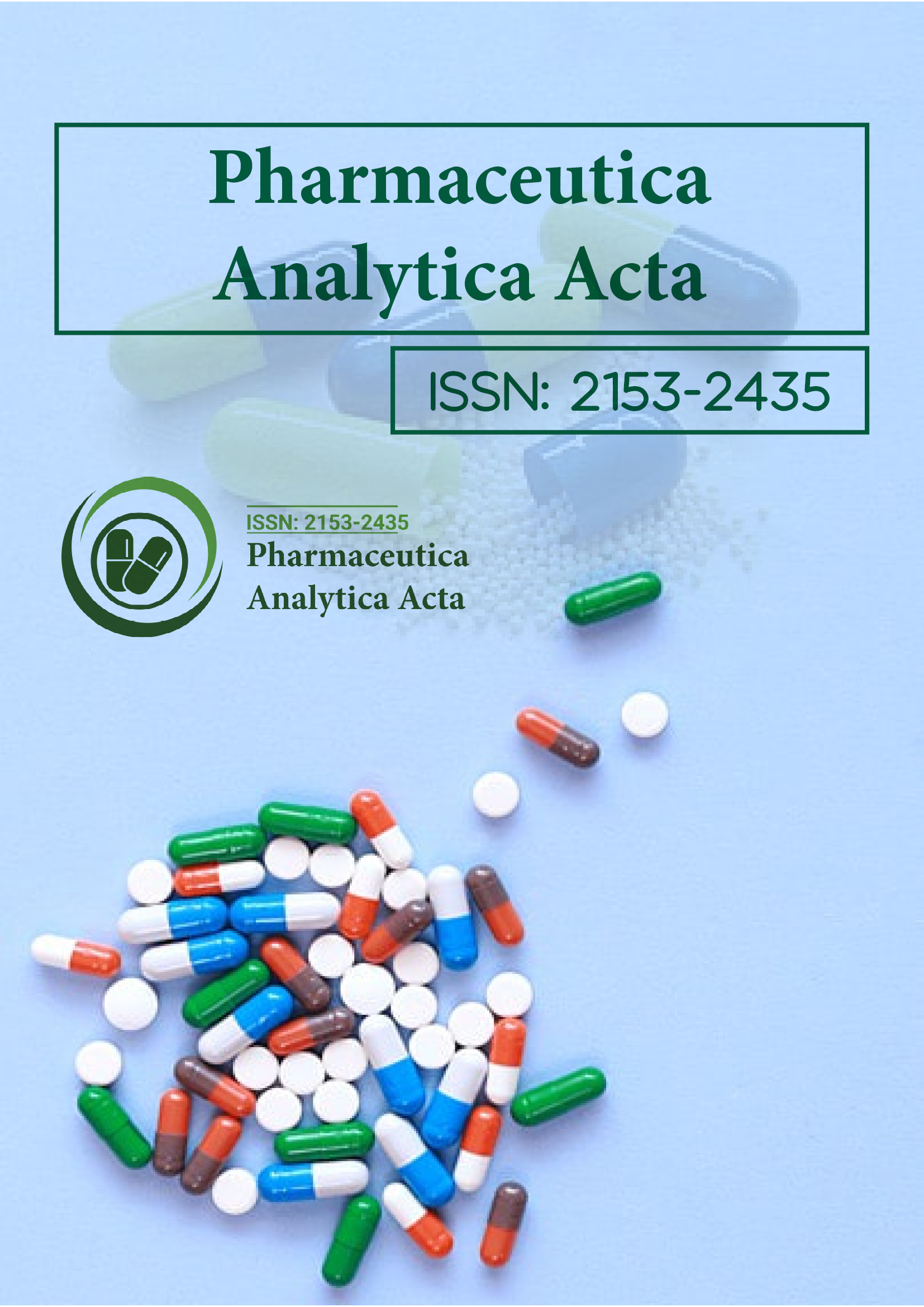
Open Access Journals
- Agri and Aquaculture
- Biochemistry
- Bioinformatics & Systems Biology
- Business & Management
- Chemistry
- Clinical Sciences
- Engineering
- Food & Nutrition
- General Science
- Genetics & Molecular Biology
- Immunology & Microbiology
- Medical Sciences
- Neuroscience & Psychology
- Nursing & Health Care
- Pharmaceutical Sciences
Research Article - (2025) Volume 16, Issue 2
Formulation and Evaluation of Herbal Shampo
Sandip Chaudhari*, Tarannum Sayyad, Prashant Nikumbh, Bhavesh Chaudhari, Apurva Patil, Snehal Patil, Sanika Patil and Akshay PatilReceived: 30-Nov-2023, Manuscript No. PAA-23-24211; Editor assigned: 04-Dec-2023, Pre QC No. PAA-23-24211 (PQ); Reviewed: 18-Nov-2023, QC No. PAA-23-24211; Revised: 01-Apr-2025, Manuscript No. PAA-23-24211 (R); Published: 09-Apr-2025, DOI: 10.35248/2153-2435.25.16.816
Abstract
The aim of this study was to formulate and evaluate a completely herbal shampoo which is at par with the other natural shampoo available in the market. We formulated an herbal shampoo by using plant extracts which are commonly used traditionally and lauded for their hair cleansing actions across Asia. All the ingredients used to formulate shampoo are safer than silicone sand polyquaterniums synthetic conditioning agents can greatly reduce the hair or protein loss during combing. Instead of using cationic conditioners we have used Sheekakai, Amla, Neem, Aloe vera and other plant extracts to provide the conditioning effects several tests were performed to evaluate and compare the physicochemical properties of both prepared and marketed shampoos. Our prepared shampoo showed comparable result with that of marketed shampoo for quality control tests but further research and development is required to improve its overall quality.
Keywords
Herbal shampoo; Aloe vera; Neem; Quality control; Hair loss
Introduction
People often complain about various brand of a shampoo that has caused various conditions such as scalp irritation, hair loss. Herbal shampoo is the cosmetic preparations that with the use of traditional ayurvedic herbs are meant for cleaning the hair and scalp just like regular shampoo. It is a hair care product, typically in the form of viscous liquid that is used for cleaning hair. There are many different types of ingredients for making an herbal shampoo. Each ingredient has specific activity in herbal shampoo’s formulation. In synthetic shampoos, surfactants (synthetic) are added mainly for their cleansing and foaming property, but the continuous use of these surfactants leads to serious effects such as eye irritation, scalp irritation, loss of hair, and dryness of hairs. Alternative to synthetic shampoo we can use shampoos containing natural herbals. However, formulating cosmetic products containing only natural substances are very difficult. Though there are different types of skin cleansers, but the hair cleansing preparations can be grouped into only one category and are called as shampoo. They are basically water based products containing mainly surfactants [1]. Its primary function is of cleansing the hair of accumulated sebum, scalp, debris and residues of hair grooming preparations. The herbal shampoo although better in performance and safer than the synthetic ones will be popular with consumers. Its primary function is of cleansing the hair of accumulated sebum, scalp, debris and residues of hair grooming preparations. The herbal shampoo although better in performance and safer than the synthetic ones will be popular with consumers. Even though the leaves of Murraya konegii wear traditional used for hair care. Hence in the present study we are interested to formulating an herbal shampoo containing extract of Murraya koenegii extract. Shampoos are of various types, like powder shampoo, clear liquid shampoo liquid shampoo, lotion shampoo, solid gel shampoo, medicated shampoo, liquid herbal shampoo etc. Herbal shampoos are concerned in stability criteria, depending upon the nature of the ingredients, they may be simple or plain shampoo, antiseptic or antidandruff shampoo and nutritional shampoo containing vitamin, amino acids, proteins hydrolysate. The selection of active ingredients for hair care powders is based on the ability of the ingredient to prevent skin damage as well as to improve the quality of skin by cleansing, nourishing and protecting the skin. As far as herbal shampoos are concerned in stability criteria. The major ingredients used in making a shampoo are detergents (surfactants), conditioning and active ingredients for hair growth, additives that modify the surfactant effect (viscosity control agents, foam stabilizers and viscosity modifiers), preserve the product (preservatives) and increase its appearance (fragrances, essence). Some of these additives have to be added in a shampoo formulation to increase its stability and safety shampoos are most probably used as cosmetics. It is a hair care product that is used for cleaning scalp and hair in our daily life. Shampoos are most likely utilized as beautifying agents and are a viscous solution of detergents containing suitable additives preservatives and active ingredients. It is usually applied on wet hair, massaging into the hair, and cleansed by rinsing with water. The purpose of using shampoo is to remove dirt that is buildup on the hair without stripping out much of the sebum. Many synthetic shampoos are present in the current market both medicated and no medicated; however, herbal shampoo popularized due to natural origin which is safer, increases consumer demand and free from side effects. In synthetic shampoos, surfactants (synthetic) are added mainly for their cleansing and foaming property, but the continuous use of these surfactants leads to serious effects such as eye irritation, scalp irritation, loss of hair and dryness of hairs. Alternative to synthetic shampoo we can use shampoos containing natural herbals. However, formulating cosmetic products containing only natural substances are very difficult. There are a number of medicinal plants with potential effects on hair used traditionally over years around the world and are incorporated in shampoo formulation. These medicinal plants may be used in extracts form, their powdered form, crude form, or their derivatives to develop a shampoo containing an only one natural substance which would be safer with milder effect, then the synthetic shampoo is difficult and also it should possess good foaming, detergency, and solid content as such synthetic shampoo. Hence, we considered in detailing an unadulterated natural cleanser utilizing conventional technique using regularly utilized plant material for hair washing safe and free from side effects. Synthetic surfactants are added to shampoo primarily for the foaming and cleansing action but their regular use leads to dryness of hairs, hair loss, irritation to scalp and eyes. Herbal formulations are considered as alternative to synthetic shampoo but formulating cosmetics using completely natural raw material is a difficult task. There are large numbers of medicinal plants which are reported to have beneficial effects on hair and are commonly used in formulation of shampoo. These plant products may be used in their powdered form, crude form, purified extracts, or derivative form. It is extremely difficult to prepare an herbal shampoo using a single natural material that would be milder and safer than the synthetic ones and at the same time would compete favorably with its foaming, detergency and solid content [2]. We, therefore, considered to formulate a pure herbal shampoo using traditionally and commonly used plant materials for hair washing in India and gulf region especially in Oman. The pericarp of Spindus mukorossi, commonly known as Soapnut or reetha, fruits of Phyllanthus emblica commonly known as amla, and dried pods of Acacia concinna (Sheekakai) have traditionally been used in Indian folklore system for centuries for washing hair. Reetha and Sheekakai produce rich lather when shaken with water due to their high content of saponins. They are also known to produce beneficial effects on skin and other organ systems. Amla fruit is rich in vitamin C and is employed in hair preparations as antidandruff agent, hair growth promoter and to strengthen hairs. The Ziziphus spinachristi tree, known as Sidr in Arabic, is indigenous to the middle east including Oman, and its leaves are traditionally used by women to wash, darken and lengthen hairs. It is reported to contain four saponin glycosides that help in removing excess sebum without causing adverse reactions. Saponins also exhibit antibacterial and antifungal activities that make them important ingredients of cosmetic applications. This study was designed to formulate an herbal shampoo and to evaluate and compare its physicochemical properties with the marketed synthetic and herbal shampoo in search of a safe and effective cosmetic product (Table 1).
Ideal characters of herbal shampoo
• Should effectively and completely remove the dust, excessive sebum.
• Should effectively wash hair.
• Should produce a good amount of foam.
• The shampoo should be easily removed by rinsing with water.
• Should leave the hair non dry, soft, lustrous with good, manageability.
Benefits of herbal shampoo
• More shine.
• Less hair loss.
• Long lasting colour.
• Stronger and more fortified hairs.
• All natural, no chemicals.
• Won’t irritate skin or scalp.
Advantages of herbal shampoo
• Pure and organic ingredient.
• Free from side effects.
• No animal testing.
• Earth and skin friendly.
• No petroleum based ingredients.
| Sr. no | Constituent | Biological source | Family | Uses |
|---|---|---|---|---|
| 1 | Henna | Dried leaves of Lawsonia inmermis | Lythraceae | Growth of hair |
| 2 | Neem | Dried leaves of Azadiractra Indica | Miliaceae | Prevent the dryness of hairs |
| 3 | Amla | Dried ripe fruits of Embelica officinalis | Euphorbiaceae | Darkening of hairs |
| 4 | Hibiscus | Dried leaves of Hibiscus rosea | Miliaceae | Prevent hair loss and hair growth |
| 5 | Shikakai | Dried pods of Acacia concinna | Mimosaceae | Anti-dandruff |
| 6 | Ritha | Dried fruits of Sapindus mukorossi | Sapindaceae | Detergent and anti-dandruff |
| 7 | Aloe vera | Dried leaves of Aloe barbadensis | Liliaceae | Conditioner |
Table 1: Ingredients used in formulation.
Materials and Methods
Sample collection
Plant materials were obtained from the forest of Jamner Taluka in Jalgaon district, Maharashtra India and were identified and authenticated by a botanist of Kaviyitri bahinabai Chaudhari north maharashtra university, Jalgaon. Azadiractra indica, Hibiscus rosa, Emblica officinalis, Lawsonia leaves were collected from the forest of Jamner, Jalgaon and were authenticated by the Pharmacognosy professor, at Dr. Babasaheb ambedkar university, university, Lonere. Indulekha Shampoo® (Unilever, Middle East) were purchased from the local supermarket. Methyl paraben and gelatin were obtained as gift sample by blue cross laboratories, Mumbai [3].
Preparation of plant extracts
10 g of Henna leaves, Neem leaves, 5 gm of Patel’s of Hibiscus flower were washed under running water to remove foreign substances, homogenized and boiled in hot water for 4 h. The aqueous extract was filtered and concentrated to obtain semi solid mass (yield: 11%w/w). Aqueous extracts of Sheekakai and amla were also prepared by the similar method (yield: 8.3% w/w and 8% w/w respectively). However, Reetha pericarps were extracted by cold maceration method using 70% ethyl alcohol to obtain 2.5 g of solvent free semi solid mass (yield 11.2% w/w) [4].
Preparation of rose oil
10 gm of rose petals collected from garden and dried under shade for 1 day and then boiled with 20 ml of olive oil and 1 gm of Cinnamon bark for 4 hours then keep the solution for 24 hrs. On next day filter the solution by using muslin cloth [5].
Formulation of herbal shampoo
The plant extracts were mixed in different proportions to obtain a shampoo whose formula is shown in Table 2. Herbal extracts were added to 10% gelatin solution and were mixed by shaking for 20 min. Lemon juice (1 ml) and Methyl paraben were also added with stirring. Finally the pH of the solution was adjusted by adding sufficient quantity of 1% citric acid solution. Few drops of rose essential oil were also added to impart aroma to the prepared shampoo and the final volume was made to 100 ml with gelatin solution then add rose oil for fragrance (Figures 1-3) [6].
| Material | Quantity |
|---|---|
| Reetha | 2.5 gm |
| Shikakai | 2 gm |
| Neem | 1 gm |
| Heena | 1.5 gm |
| Hibiscus | 0.5 gm |
| Amla | 2 gm |
| Aloe vera | 1 gm |
| Lemon juice | 1 ml |
| Methyl paraben | 1 ml 0.05% solution |
| Gelatin | q.s |
| Rose oil | q.s |
Table: 2 Compositions of formulated herbal shampoo.
Figure 1: Marketed shampoo (After 15 day).
Figure 2: Formulated shampoo (After 15 days).
Figure 3: Marketed shampoo and formulated shampoo (After 30 days).
Evaluation of formulated and commercial shampoo
To evaluate the quality of commercial and prepared formulations, several quality control tests including visual assessment, physicochemical controls conditioning performance tests were performed [7].
Physical appearance/visual inspection: The formulation prepared was evaluated for the clarity, color, odor and foam producing ability.
Determination of pH: The pH of 10% v/v shampoo solution in distilled water was measured by using pH meter (Mi 151, Martini instruments) at room temperature [8].
Determination of % of solid contents
4.0 grams of shampoo were placed in a previously clean, dry and weighed evaporating dish. The dish and shampoo was weighed again to confirm the exact weight of the shampoo. The liquid portion of the shampoo was evaporated by placing the evaporating dish on the hot plate. The weight and thus % of the solid contents of shampoo left after complete drying was calculated [9].
Dirt dispersion test: Two drops of shampoo were added to 10 ml of distilled water taken in a large test tube. To this solution, one drop of India ink was added and the test tube was stoppered and shaken ten times. The amount of ink in the foam was indicated by the rubric such as none, light, moderate or heavy [10].
Evaluation parameter of shampoo
Evaluation parameter of shampoo shows in Table 3.
| Shampoo | Surface tension | Viscosity | pH |
|---|---|---|---|
| Formulated shampoo | 41.63 ± 0.2967 | 2590 ± 6.057 | 5.0 ± 0.01528 |
| Marketed shampoo | 42.11 ± 0.43501 | 2519 ± 7.674 | 6.9 ± 0.16803 |
Table 3: Evaluation parameter of shampoo.
Surface tension measurement: The surface tension of 10% w/v shampoo in distilled water was measured using stalagmometer at room temperature.
Test to evaluate foaming ability and foam stability: Foaming ability was determined by using cylinder shake method. Briefly, 50 ml of the 1% commercial or formulated shampoo solution was placed into a 250 ml graduated cylinder; it was covered with one hand and shaken 10 times. The total volume of the foam content after 1 min of shaking was recorded. Foam stability was evaluated by recording the foam volume after 1 min and 4 min of shake test [11-15].
Wetting time test: A canvas paper was cut into 1-inch diameter discs having an average weight of 0.44 g. The smooth surface of disc was placed on the surface of 1% v/v shampoo solution and the stopwatch started. The time required for the disc to begin to sink was noted down as the wetting time.
Evaluation of conditioning performance: A hair tress of an Indian woman was obtained from a local salon. It was cut into four swatches of the tresses with approximately the length of 10 cm and the weight of 5 g. As watch without washing served as the control. Other three tresses were washed with the commercial and formulated shampoos in an identical manner. For each cycle, each tress was shaken with the mixture of 10 g of a sample and 15 g of water in a conical flask for 2 min and then rinsed with 50 ml water. Afterward, each tress was left for air drying at room temperature. The tresses were washed for maximum ten cycles. The conditioning performance of the shampoos i.e., smoothness and softness, was evaluated by a blind touch test, administered to twenty randomly selected student volunteers. All the students were blind folded and asked to touch and rate the four tresses for conditioning performance from score 1 to 4 (1 ¼ poor; 2 ¼ satisfactory; 3 ¼ good; 4 ¼ excellent) (Table 4) [16].
| Score | Control |
|---|---|
| 1 | 8 |
| 2 | 5 |
| 3 | 6 |
| 4 | 1 |
Table 4: Conditioning performance of formulated shampoo.
The mean score based on the opinion given by the volunteers from student population (n=20) on the conditioning effect of the shampoos on the selected tresses.
Score 1-poor, score 2-fair, score 3-good and score 4-excellent
Results and Discussions
Formulation of herbal shampoo
A pure herbal shampoo was formulated by mixing aqueous/ alcoholic extracts of Henna, Hibiscus, Reetha, Amla, Neem and Sheekakai indefinite amount as shown i n Table 2. A good shampoo must have adequate viscosity to facilitate removal from the bottle but must not drip down from the hair during use. A variety of natural materials is available for use as viscosity builders. We used 10% gelatin solution for this purpose as it shows pseduoplastic behavior and forms clear solutions. Lemon juice (1 ml) was also added as natural antioxidant, chelating agent and antidandruff agent to maintain the acidic pH of formulation. Shampoo was further preserved by the addition of little amount of methyl paraben (Table 5). Final formula of the prepared shampoo is presented in Table 2.
|
Formulated shampoo |
Marketed shampoo (Indulekha) |
|
|---|---|---|
|
Color |
Dark brown |
Dark brown |
|
Transparency |
Clear |
Clear |
|
Odor |
Pleasant |
Pleasant |
|
pH |
5 |
6.9 |
|
Foam volume (mL) |
Uniform |
Uniform |
|
Foam type |
25 |
20 |
|
Wetting time(s) |
120 |
100 |
|
Dirt dispersion |
Light |
Light |
|
Solid content (%) |
23.75 |
22.4 |
Table 5: Physiochemical evaluation of formulated and marketed shampoo.
Evaluation of shampoos
Comparative effectiveness of the formulated herbal and commercial shampoo were evaluated by performing some simple physicochemical tests, results of which are discussed below [17].
Physical appearance/visual inspection: A shampoo like any other cosmetic preparation should have good appealing physical appearance. The formulated and marketed shampoos were evaluated for physical characteristics such as color, odor and transparency (Table 5). Our prepared shampoo was transparent, dark brown and had good odor. No significant difference was observed in terms of odor, transparency and foaming characteristics between commercial and formulated shampoo except for color [18].
pH: Most shampoos are formulated as either neutral or slightly alkaline to minimize the damage to hair. The pH of shampoo also helps in minimizing irritation to the eyes, enhances the qualities of hair and maintains the ecological balance of the scalp. The pH of tested commercial shampoos was found within the preferred range (between 7and 5) and are presented in Table 3. The acid balanced values were observed with commercial shampoos (indulekha 6.9) but the pH of formulated shampoo was found to be nearly 5 [19].
% of solid contents: Good shampoos usually have 20% to 30% solid content as it is easy to be applied and rinse out from the hair. If it doesn't have enough solid it will be too watery and wash away quickly, similarly too many solids will be hard to work into the hair or too hard to wash out. The percent solid contents of all the tested shampoo was found within the range of 22 to 25%. Dirt dispersion is an important and is expected to wash out easily [20].
Dirt dispersion: Criterion for evaluation of cleansing action of shampoo. Shampoos that because the ink to concentrate in the foam is considered of poor quality because ink or dirt that stays in foam is difficult to rinse away and gets re-deposited on the hair. Therefore, the dirt should stay in the water portion for achieving better cleansing action. All shampoo concentrated the ink in the water portion, ensuring their satisfactory cleaning ability and actual effectiveness [21].
Surface tension: The term indicates the amount of surfactant present in shampoo to reduce the surface tension. Lesser the surface tension stronger is the cleaning ability of the shampoo. A shampoo is considered of good quality if it decreases the surface tension of pure water from 72.28 dyn/cm to about 40 dyn/cm. All the tested shampoo showed similar reduction in surface tension ranging from 31.68 to 38.72 dyn/cm. The reduction in surface tension is an indication of their good detergent action. The formulated shampoo reduced the surface tension to 38.72 dyn/cm which is comparable to Indulekha® (38.36 dyn/cm). However, among all the shampoo, indulekha® (38.36 dyn/cm) has the lowest surface tension indicating that it has the strongest cleaning ability. The commercial synthetic or semi herbal shampoos may contain excessive detergents, which can strip the hair of up to 80% of the oil and thus damage the hair [22].
Foaming ability and foaming stability: Foaming or lathering is very important to the consumer and therefore, it is considered as an important parameter in evaluation of shampoo. Herbal essences and formulated shampoo produced the foam volume above 100 mL (115,113 ml respectively) while dove shampoo generated a foam volume of 92 ml. The foams generated by formulated shampoo were small, compact, uniform, denser and stable similar to commercial samples. All tested shampoo had the same foam volume for 5 min showing that their foam has good stability.
Wetting time: The wetting ability of a surfactant is dependent on its concentration and is commonly used to test its efficacy. The canvas disc method is quick, efficient and reliable test to evaluate the wetting ability of a shampoo. It can be concluded that indulekha contains the maximum concentration of detergents because it had the least wetting time by contrast our formulated shampoo exhibited maximum wetting time so, it contains minimum concentration of detergents.
Conditioning performance: Conditioning performance of three shampoos based on the mean scores of student referees is presented in. Majority of the students rated that the tress washed with indulekha provided the best conditioning performance and as expected the control tress (without washing) got the minimum score (1.1). The score of the conditioning performance of the tresses washed with formulated shampoo was found to 3.0 out of 4 and was comparable with the scores of marketed shampoos. The results clearly indicated that the formulated shampoo is having good conditioning performance level.
Conclusion
The aim of this study was to formulate and evaluate a completely herbal shampoo which is at par with the other natural shampoo available in the market. We formulated an herbal shampoo by using plant extracts which are commonly used traditionally and lauded for their hair cleansing actions across Asia. All the ingredients used to formulate shampoo are safer than silicone sand polyquaterniums synthetic conditioning agents can greatly reduce the hair or protein loss during combing. Instead of using cationic conditioners we have used Sheekakai, Amla, Neem, Aloe vera and other plant extracts to provide the conditioning effects several tests were performed to evaluate and compare the physicochemical properties of both prepared and marketed shampoos. Our prepared shampoo showed comparable result with that of marketed shampoo for quality control tests but further research and development is required to improve its overall quality.
References
- Saad AH, Kadhim RB. Formulation and evaluation of herbal shampoo from Ziziphus spina leaves extract.
- Kumar A, Mali RR. Evaluation of prepared shampoo formulations and to compare formulated shampoo with marketed shampoos. Evaluation. 2010;3(1):025.
- Baran R, Maibah HI. Cosmetic dermatology in children. Text book of cosmetic dermatology (2nd Ed.) CRC Press, London. 1998:507-508.
- Boonme P, Pakpayat N, Yotmanee K, Kunlawijitrungsee S, Manee D. Evaluation of shampoos containing silicone quaternary microemulsion. J Appl Pharm Sci. 2011:59-63.
- Chen YF, Yang CH, Chang MS, Ciou YP, Huang YC. Foam properties and detergent abilities of the saponins from Camellia oleifera. Int J Mol Sci. 2010;11(11):4417-4425.
[Crossref] [Google Scholar] [PubMed]
- Halith SM, Abirami A, Jayaprakash S, Karthikeyini C, Pillai KK, Firthouse PM. Effect of Ocimum sanctum and Azadiracta indica on the formulation of antidandruff herbal shampoo powder. Pharm Lett. 2009;1(2):68-76.
- Gaud RS, Gupta GD. Practical physical pharmacy. 1st ed. New Delhi: C.B.S. Publisher and Distributer; 2001:81e105.
- Ilton PS, Deptuck R, Bousfield B, Verge D, Antoni K, MacRae L, et al. Can J Neurosci. Nurs 2007;29(1):14e9.
- Ishii MK. Objective and instrumental methods for evaluation of hair care product efficacy and substantiation of claims. Hair and Hair Care. 2018:261-302.
- Khushboo PS, Jadhav VM, Kadam VJ, Sathe NS. Psoralea corylifolia Linn. “Kushtanashini”. Pharmacogn Rev. 2010;4(7):69.
[Crossref] [Google Scholar] [PubMed]
- Klein K. Evaluation of shampoo foam. Cosmet Toilet Mag. 2004;119(10):32e5.
- Ross J, Miles GD. An apparatus for comparison of foaming properties of soaps and detergents. Oil Soap. 1941;18:99-102.
- Nafisy AT. A review of traditional medicine in Iran. Isfahan: Isfahan University Publications. 1989;133.
- Hadkar UB, Ravindra RP. Interfacial Tension using a simple laboratory technique. IJPER. 2009;43(2):187-191.
- Gaud RS, Gupta GD. Practical Physical Pharmacy, 1st ed., C.B.S. Publisher and Distributer, New Delhi, 2001;81-105.
- Eldridge JM. The analysis of surfactants in cosmetics. InSurfactants in Cosmetics. Routledge. 2017:83-104.
- Mainkar, Jolly. Evaluation of commercial herbal shampoos. Int J Cosmet Sci. 2000;22(5):385-391.
- Aghel N, Moghimipour E, Raeis DN. Formulation of a herbal shampoo using total saponins of Acanthophyllum squarrosum. 2007.
- Kaila AN. Textbook of industrial Pharmacognosy, CBS publishers and distributers, New Delhi: 268.
- Mithal BM, Saha RN. Handbook of cosmetics, first edition, VallabhPrakashan 2003: 1-10,110-121.
- Kokate CK, Purohit AP, Gokhle SB, Pharmacognosy, Morality Prakashan, 49th edition: 8.17- 8.19,9.9-9.15, 9.100-9.101, 10.4-10.5, 14.91-14.94, 19.2-19.4.
- Mainkar AR, Jolly CI. Formulation of natural shampoos. Int J Cosmet Sci. 2001; 23(1):59-62.
[Crossref] [Google Scholar] [PubMed]
Citation: Chaudhari S, Sayyad T, Nikumbh P, Chaudhari B, Patil A, Patil S, et al. (2025) Formulation and Evaluation of Herbal Shampo. Pharm Anal Acta. 16:816.
Copyright: © 2025 Chaudhari S, et al. This is an open-access article distributed under the terms of the Creative Commons Attribution License, which permits unrestricted use, distribution, and reproduction in any medium, provided the original author and source are credited.
